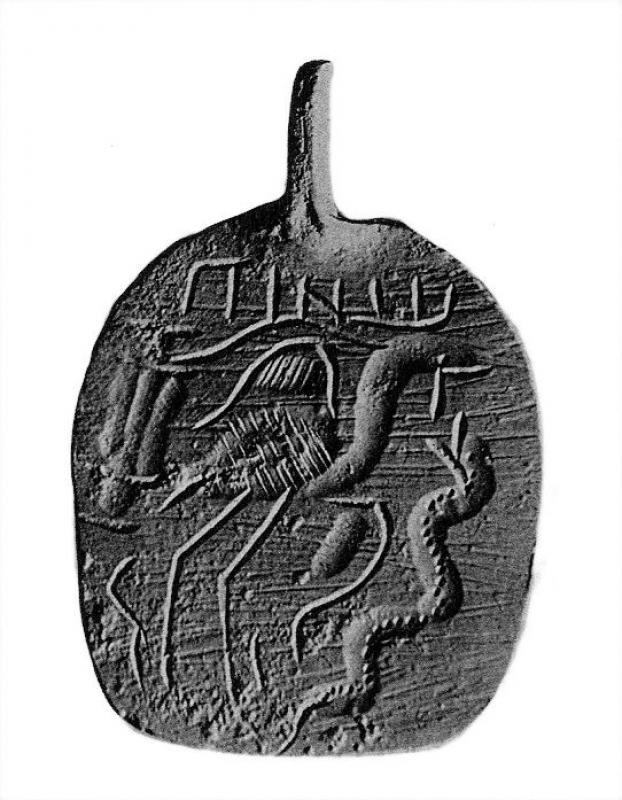Bonner, SMA, 212.
owing to the maker's misunderstanding his pattern. The same pendant interchanges the position of the lion and the dog. We have seen that there is a variation in the obverse design — the addition of a lion under the rider and the transfixed spirit of evil (so five out of eight examples); but in spite of these trivial differences the group is a fairly coherent one. The larger specimens bear on the reverse, above the evil eye, the inscription Ιαω σαβαωθ Μιχαηλ βοηθι. A smaller one has an indistinct εἷς θεός (D. 302).
An entirely different reverse design is best represented by a pendant in my collection, a broad, spadelike amulet, the bottom almost straight (D. 304.). The rider design on the obverse is sketchily incised; the female figure is little more than a misshapen roll of flesh. The reverse is mainly occupied by a large bird with long legs and neck but a short bill, almost certainly intended for an ostrich. It stands to right, its open bill just over a large open-mouthed snake with a row of spots indicated by punctures in the metal. The snake is apparently raising itself (in a manner impossible fact) to attack the bird. Two much smaller snakes or worms rear up from the ground in the same way, and in the field is an uncertain object, approximately cylindrical with some transverse ridges, which may be intended for a larva of some sort. Behind the ostrich is a small structure like an altar made of three pillars with a table across them, and with an upper piece resembling a flowerpot with wide rim.
A curious feature of this design is a line which curves upward from the upper part of the altar and then descends slightly to the back of the bird's head. If it is meant for a cord, like that which fastens an ibis to an altar on a well-known type of stomach amulets, the artist has ignored the laws of gravity and so avoided bringing the cord into contact with the bird's wing, which is just below. The cord cannot be merely an exaggerated crest; the head of the ostrich has no such plume. Above the whole reverse design stands the word πινω.
Two other pendants in my possession show variations from this type. On one the bird has a fairly long bill, and might be an ibis or even a crane. Behind is a tree (cypress ?), but the bird is not tied to it. Above there is a curiously looped line, perhaps a suggestion of a magical knot. The usual πινω is wanting (D. 305). The other has on the obverse two unusual though unimportant variations, a six-pointed star under the horse's belly and a triple loop at the bottom. The suspension loop and part of the plaque have been broken off, leaving it uncertain whether the word πινω was present or not. The bird has a backward-projecting crest — it is certainly not a cord in this instance — and there is an altar behind. In the lower field at right, between the bird and the snake, there is a large eight-rayed ring sign and in the corresponding position at the left, a looped curve. Below, εἷς θεός, indistinct and not quite certain (D. 306).
A specimen published by Schlumberger, which seems to have been rather crudely executed, throws no further light on the design.21 The line connecting
21 Schlumberger, REG 5, 81.
Last modified: 2012-11-01 23:33:06
Link: cbd.mfab.hu/pandecta/1657


